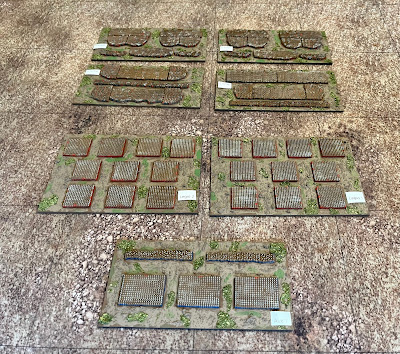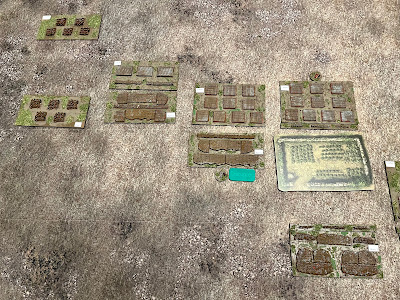These are the new rules by Mark Backhouse for fighting the epic big battles of the ancient world. I played these at Partizan in a refight of Cannae. The outcome of using Hannibal's tactics was historical, and it was the first time I felt this classic battle had been faithfully reproduced on the tabletop. The downsize (pun intended) is that the game is designed to be played with micro armies (typically 2mm). My experience of playing 3mm WW2 games has not previously encouraged me in this direction. However, here, the unit blocks are placed on a large base, which is easy to identify and label.
So, I bought the rules and a batch of figures from Antonine Miniatures (Warbases). My first matching armies were the Dacians and Romans. At this scale, the Dacians will do for almost any warband army of the period. I also bought some pike blocks intending to do some of Alexander's early battles as well.
This was the first batch of painting. I glued the metal blocks onto the bases, which are standard and a little deeper for the Roman legions. The warbands looking suitably irregular and the Roman ten cohort legion supported by auxiliaries. After priming them in brown I painted the legions in red around the edges and the auxiliaries in blue. Then dry brushed the helmets with a few crests for officers. The Dacians got dabbed a range of colours. Then a fine sandy base mix, followed by a green foilage mix.
The same approach for the second batch, which includes cavalry, two camps and skirmishers. I also bought some scenery pieces from Warbases.
On to the tabletop, meant reading the rules. Much helped by my memory of the participation game at Partizan. Everything you need is in the nicely laid out booklet, plus a downloaded QRF and command board from the Two Fat Lardies site. The game is played on a grid, typically 75mm, so I used my 150mm To the Strongest mat.
You dice for command points and allocate them to the command board. I'm embarrassed to say we largely forgot to use these, but they give various benefits, although you can only use a point once. It doesnt seem to overpower the game as sometimes happens in other rules.
The key mechanism is activation, which includes movement, combat, charge, shooting and reform. A roll on a D6 means variable movement, which, as I discovered, makes it difficult to keep a neat battle line. This matters as isolated units can come up against supported enemies. Manoevre, which means anything other than straight ahead also has to be diced for and failure means the end of your turn. So, do it last. It also discourages unhistorical dashing about the tabletop, which is all too common in osome other rules.
Combat and shooting is straightforward, based on a unit combat factor with typical modifiers. If you lose then the combat result table can result in a pushback or worse. You are also likely to attract setback or disaster cards which are drawn from a pile and placed face down. These have numbers which added together can reach the break point for the army. We didn't reach that when we had to call it a night, but my Dacians were losing heavily. Never mind, wait till the Romans get into the mountains!
The book has army lists and scenarios as well as some basic campaign rules. Overall, we had a good game and will certainly return to these for when the big battle itch has to be scratched.






Its a great game and so easy to get set up with the Antonine range.
ReplyDeleteEasy to set up is certainly a plus.
DeleteI bought the rules, but haven’t played them yet. I suspect I probably won’t - but that’s mostly because I play on a small tabletop with either DBA or 1/2 DBA sized basing. I prefer a irregular Miniatures 2mm blocks and strips, as the Antonine ranges seem rather too regular (no pun intended) whereas the IM 2mm blocks are clearly really, really small warriors - even if some of the moulds are beginning to show their age.
ReplyDeleteCheers,
Geoff
Hi Geoff, why not place 2 or even 4 irregular bases together to form a unit in Strength and Honour? You don’t need to use any specific figures to play. Or if you prefer the smaller unit size bases just play on a board with smaller grid squares and try them out. There’s no need to stick to one specific scale, range or table size to play them.
ReplyDeleteCheers
Mark
I considered this to fit my 15mm To the Strongest grid (100mm squares). But I can't see a problem with going smaller if you want.
DeleteYes, that had occurred to me. TBH I’d rather have, say, 8 half sized DBA armies (each 12 elements) than 2 large armies each with lots of elements/bases. My main problem is I don’t play enough games as it is… Roll on retirement 👴🎲
DeleteCheers,
Geoff
I found them a great set of rules and they've really piqued my interest in teenie-weenie figures. I tried them out using some 10mm Paper soldiers from Peter Dennis but am planning to pick up some of the 2mm Antonine Mjniatures figures from Warbases. Slightly worried about getting a decent effect from painting them though.
ReplyDeleteI don't think you will have any problem painting them. In addition to the description above I would also suggest use bright colours. I normally use a wash on my figures but for 2mm you need more 'pop'.
Delete